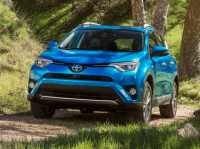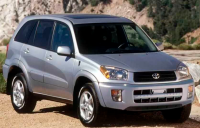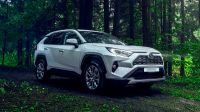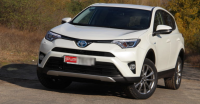Toyota RAV4 vs Subaru Forester: we chose this pair on the principle of price and engine power proximity, both with all-wheel drive. Among the exercises - entering a slippery mountain.
Toyota Rav 4 vs Subaru Forester: test comparison.
Both competitors have Japanese roots. The cars are also different in ideology, nevertheless, they are very close in price and power. A set of our branded exercises will reveal the difference.
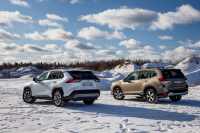 At our disposal: Toyota Rav 4 with the engine of 2.5 liters, 199 hp and torque of 243 Nm. Against it will be the Subaru Forester with the same 2.5-liter engine with 185 hp and 239 Nm of torque. Both cars are all-wheel drive, but the types of drives are different.
At our disposal: Toyota Rav 4 with the engine of 2.5 liters, 199 hp and torque of 243 Nm. Against it will be the Subaru Forester with the same 2.5-liter engine with 185 hp and 239 Nm of torque. Both cars are all-wheel drive, but the types of drives are different.
The Forester has permanent all-wheel drive.
Toyota has a new all-wheel drive system with adaptive torque distribution to the rear wheels (for Prestige and Prestige Sasety configurations).
Front View
Subaru Forester
The overall concept at the front is a multi-story panel. There are two screens on the center console: one above the other. The upper one is responsible for the flow and temperature reference information, the lower one for the multimedia system.
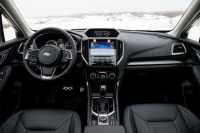 The interior is solid, there are a lot of buttons, and the finish is of high quality. The eyes are not confused, everything is in its place.
The interior is solid, there are a lot of buttons, and the finish is of high quality. The eyes are not confused, everything is in its place.
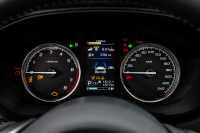 Not the largest built-in screen displays everything you need, however, the main instruments are on the arrow, the usual
Not the largest built-in screen displays everything you need, however, the main instruments are on the arrow, the usual
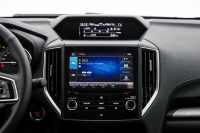 Very clear division of information assignment. The upper one is responsible for statistical data and the climate in the cabin. It also displays the data from the electronic assistants. The lower one is completely dedicated to multimedia.
Very clear division of information assignment. The upper one is responsible for statistical data and the climate in the cabin. It also displays the data from the electronic assistants. The lower one is completely dedicated to multimedia.
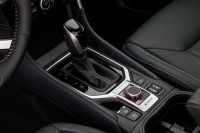 The seat is finished with perforated leather, has an electric drive.
The seat is finished with perforated leather, has an electric drive.
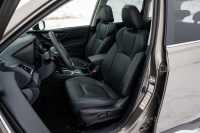 Watching all this wealth from the driver's seat, you feel like the captain of something very large and complex. Subaru designers have provided for a lot of electronic assistants. Some of them will turn off the engine at a traffic light. While others will remind that the stream has moved and it is time to go. There is also adaptive cruise control and emergency braking function. Subaru's systems are optical - there are two "machine vision" video cameras lurking under the ceiling on the windshield.
Watching all this wealth from the driver's seat, you feel like the captain of something very large and complex. Subaru designers have provided for a lot of electronic assistants. Some of them will turn off the engine at a traffic light. While others will remind that the stream has moved and it is time to go. There is also adaptive cruise control and emergency braking function. Subaru's systems are optical - there are two "machine vision" video cameras lurking under the ceiling on the windshield.
Toyota Rav4
The interior feels spacious, there is no impression of overloaded dashboard. However, there is less light here, the lack of a sunroof affects, while the glazing line is higher.
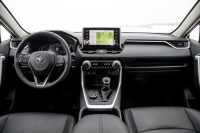 The interior is finished just as well, but completely different. The central screen is glued, there are fewer buttons. Design decisions are clearly traced: edges and notches.
The interior is finished just as well, but completely different. The central screen is glued, there are fewer buttons. Design decisions are clearly traced: edges and notches.
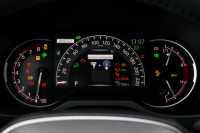 The instrument cluster has a built-in 7-inch color screen. There are no complaints about the quality of drawing. The digital instrument combines very well with the live arrows.
The instrument cluster has a built-in 7-inch color screen. There are no complaints about the quality of drawing. The digital instrument combines very well with the live arrows.
The screen of the multimedia system is 8 inches. This is quite enough to display any information. However, the thin and narrow buttons are more likely to suit a more modest car.
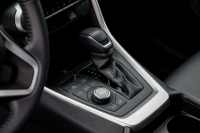 The transmission controls are gathered around the transmission lever. Clear and understandable. There is also a unit for selecting Eco/Normal/Sport driving modes, where the driver can adapt to the type of road surface.
The transmission controls are gathered around the transmission lever. Clear and understandable. There is also a unit for selecting Eco/Normal/Sport driving modes, where the driver can adapt to the type of road surface.
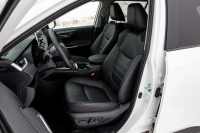 Seat leather not perforated. Electric adjustments are present.
Seat leather not perforated. Electric adjustments are present.
The side mirrors of the Rav 4 are large, on individual door panel posts. The front pillars have become thinner, visibility is now noticeably better. The aesthetics of the interior are in simplicity, combined with tactile chips. The notch on the knobs matches the notch on the inside door handles even where the eye can't reach. There is also active cruise control, distance control and sign reading systems.
Both interiors are decently designed, the availability of assistants and comfort have slightly different approaches, but are good. A solid draw.
The score is 1:1.
Back View
The back row of the Forester is nice and spacious. The large windows let in a lot of light. There are deflectors and heated seats, there are two USB sockets. There are pockets in the backs of the front seats. However, due to the sliding sunroof, the ceiling is lower.
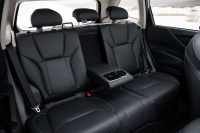 The ceiling is slightly lowered due to the sunroof. Three adults can ride here for several hours.
The ceiling is slightly lowered due to the sunroof. Three adults can ride here for several hours.
The tunnel is not high, and each passenger has a USB outlet and its own seat heating button.
So how does the Toyota respond? It's just as spacious in the back, you can fit two fists over your head, and there's a low tunnel underneath.
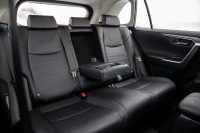 Slightly more ascetic, however, there is more space above the head.
Slightly more ascetic, however, there is more space above the head.
Minimum sufficiency, not bad and economically justified.
However, there are also disadvantages: the sofa is set lower - under the knees is empty. There are no pockets in the backs of the seats.
Nevertheless, both saloons are good, but concepts of the contenders are different - Toyota is more laconic, whereas Subaru is deliberately functional. Taking into account conceptual differences - a draw!
The score is 2:2.
Toyota Rav 4 vs Subaru Forester: trunks
The trunk of the Forester is well equipped: hooks, a 12-volt outlet, niches and a subwoofer - a rich set. Under the floor is an organizer, in which the tools are stowed, all this is covered with another molded foam. The stated volume is 505 liters.
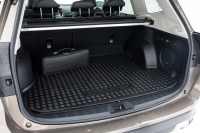 In the trunk there are hooks, a socket and a subwoofer. The equipment is not bad, but the volume is small.
In the trunk there are hooks, a socket and a subwoofer. The equipment is not bad, but the volume is small.
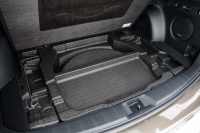 Styrofoam is and organizer, and noise insulation, a beautiful solution, under it a dock and a car jack.
Styrofoam is and organizer, and noise insulation, a beautiful solution, under it a dock and a car jack.
How will Toyota respond? 580 liters is a good bid to win, but let's go deeper into the details: niches and a two-sided floor. The floor panel can be put on the fluffy, non-slip side or the slippery side, but not the brand.
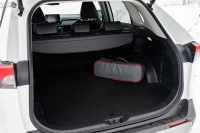 The Toyota's trunk is roomier. The speed of the electric opening of the fifth door is very slow
The Toyota's trunk is roomier. The speed of the electric opening of the fifth door is very slow
It's a comfortable, folding, double-sided floor, but the way the tool is stacked! It's just wrapped in a piece of leatherette.
A spoon of dirt was the slow opening of the trunk and the underfloor cavity. There is no organizer, only a wheelbarrow with a jack and a set of tools. By the way, about the kit: it is packed in familiar to owners of AvtoVAZ dermatin. Cheap and hearty. Still the point goes to the Rav 4 - for volume, in fact this indicator is the basic one.
The score is 3:2.
Passing an obstacle with a height of 200 mm
The ground clearance of the Toyota Rav 4 for versions with a 2.5-liter engine is 197 mm, our proprietary 200 mm high measuring tire It's just a matter of a little, to overcome an obstacle without shifting it. The Rav 4 shifts the tire a little bit.
The stated clearance is greater than the height of the tire, yet the obstacle is slightly touched.
At the start of the Subaru Forester stated ground clearance of 220 mm and still the same tire height of 200 mm. There is no doubt about the result of the race, however, the "forester" clings to the tire, but does not take away the line of cones. Of course, this is far from the best result, but objectively Forester did better, so the point goes into his piggy bank.
The score is 3-3.
Toyota Rav 4 vs Subaru Forester: Speed Lap
The test takes place on the snow in a sand pit, the track has no difficult terrain. Snow and sand is what we will test the Japanese samurais. For an objective assessment, we have a driver: one behind the wheel, the other on the back row. It goes without saying: a driver will estimate steerability, and a passenger - comfort in back. Let's go!
Toyota is the first on start: "dirt" mode, ESP is switched off, the gearbox is in sport, and there are no paddles. You would expect from the 2,5-liter motor coupled with the classical 8-gear automatic gearbox more energy. However, it did not happen.
The all-wheel-drive Rav 4 is not designed for active driving on slippery bumps. Its advantage is comfort.
Up to the first corner the car just drove, but the entry into the corner was a pleasure. The transmission, set in "dirt" mode, engaged the rear axle, making the entry into the turn relatively brisk. Still, it does not endow the Rav 4 with sporty spirit. Swept by the stern or briskly tucked the Toyota into a corner with the gas, it doesn't work. The lap time is 52 seconds. Rear passenger's ride was estimated as comfortable enough for such a drive over small bump.
Forester from the first meters showed its sporty character: the gas pedal response is clear and fast. The car follows the gas, and by dosing the traction in the corner, it is possible to change the trajectory.
The Forester, unlike the Rav 4, has an active attitude, giving the driver an opportunity to frolic.
The RAV 4 has a noticeable time that forces you to keep the throttle to the floor, while the Forester leaves a large reserve of traction. The lap time is less than 48,6 seconds. However, there is less comfort in the back, too - the "forester" is noticeably stiffer. The Forester gets a point for lap time, the Rav 4 for comfort.
The score is 5 to 5.
The Hill
Subaru is getting ready to start. We switch off ESP and drive uphill on straight wheels. Part of the climb the Forester goes on three wheels, the terrain of the climb is not simple even in summer conditions, let alone in winter.
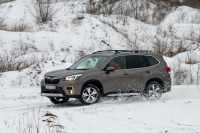 The way the Subaru drove up the hill commands respect.
The way the Subaru drove up the hill commands respect.
The permanent four-wheel drive is top-notch.
Without much hovering, the car is on the top platform of the lift. Score. Having moved into the Rav 4, we choose a suitable off-road mode. Let's drive. ESP is off, the car crawls uphill, but there is not the same confidence as in the Subaru. Still, two-thirds of the way through, the Toyota Rav 4 hangs back, spinning the front wheels.
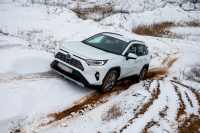 Still do not replace electronic imitations honest four-wheel drive.
Still do not replace electronic imitations honest four-wheel drive.
After spinning the wheels a bit, the Rav 4 gave out an overheat. The car is designed more for asphalt than hills.
There are two clutches on the drive shafts of the rear wheels of the Rav 4 - they provide independent control of torque delivery to the left and right rear wheels, as well as torque distribution between the front and rear wheels. The Rav 4 can simulate 100 percent locking of the rear interwheel differential in off-road conditions. And what will it give us in the end on a hill? According to our experiment, electronics takes care of the car, and the driver can also wait or choose another route.
No, we have not sat in Rav 4 on abdomen, simply distribution of torque is not so effective, as in Forester. The inscription on the dashboard: "AWD system overheated" and demand to switch off all-wheel drive became the finale of the story. It was suggested, about a rolled-out rut. In order to refuse all doubts, we shall repeat the experiment on "forester", which conquered an uphill again. Undisputed victory for Subaru Forester.
The score is 5:6.
Results: Toyota Rav 4 vs Subaru Forester
The king of the mountain is recognized Subaru Forester, as a passerby it will pass on.
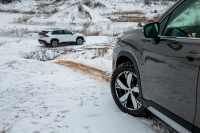 We didn't have to choose the king of the mountain. The cars made that choice for us.
We didn't have to choose the king of the mountain. The cars made that choice for us.
Nevertheless, in urban conditions, rather than extreme travel, the Toyota Rav 4 will give more comfort. Both cars are equipped with active and passive safety systems, as well as assistants to help in difficult situations. The Rav 4 has a whole arsenal of driver support, the Forester will not lag behind. Different in ideology, comfort and features, both cars will find their fans in the market of four-wheel drive crossovers.
Pricing policy
The base Rav 4 starts from 26.8 thousand dollars. For this sum it will be with a 2-liter motor and front-wheel drive. All-wheel drive automobile is possible to get, having paid in addition more than 7 thousand. Under the hood will be the same 2-liter atmospheric engine. However, there will be 18-inch wheels, two-zoned climate control, a rain sensor, parktronic and an 8-inch multimedia system. The all-wheel drive version with a 2-liter engine on 19-inch wheels with a 7-inch screen in instrument cluster and an active control system is priced at 35.2 thousand. The top version with a 2,5-liter engine, 8-speed automatic and all-wheel drive will cost 40.7 thousand, and also this version will include Toyota Safety Sense active safety system package.
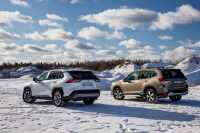 Each car has carved its own niche in the market. The owner of the Forester gets off-road priority, while the owner of the Rav 4 gets design, comfort and peace of mind, which will return good money in the aftermarket.
Each car has carved its own niche in the market. The owner of the Forester gets off-road priority, while the owner of the Rav 4 gets design, comfort and peace of mind, which will return good money in the aftermarket.
The ascetic Forester with a 2-liter motor starts from a mark of 32.7 thousand dollars. For surcharge in 120 thousand rubles there is a two-zoned climate, leather, heated steering wheel and rear seats, and also a multimedia system with 8-inch display and 6 speakers. The version ELEGANCE ES is already evaluated in 38.7 thousand dollars and adds a package of assistance systems EyeSight to everything else. Addition for a 2,5-liter engine will make 2 thousand.
The top of the art from Subaru will be Forrester PREMIUM ES, maximally packed with a 2.5-liter engine, added a huge power sunroof, a lot of shiny things in the exterior. Multimedia will get a premium Harman Kardon audio system with power amplifier, subwoofer and eight speakers. All this will cost the buyer 42.5 thousand dollars.
TOYOTA RAV4 / SUBARU FORESTER
Technical Specifications
GENERAL DATA | Toyota RAV4 | Subaru Forester |
Size, mm: | 4600 / 1855 / 1685 / 2690 | 4625 / 1815 / 1730 / 2670 |
front/rear track | 1600 - 1630 | 1565 / 1570 |
Trunk volume, l | 580 | 505 / 1775 |
Turning radius, m | No data | 5,4 |
Curb weight / gross weight, kg | 1570 - 1575 / 2015 | 1677 / 2223 |
Acceleration time 0 - 100 km/h, s | No data | 9,5 |
Maximum speed, km/h | No data | 207 |
Fuel / fuel reserve, l | А92 / 55 | А95 / 63 |
Fuel consumption: urban / suburban / mixed cycle, l/100 km | No data | 9,3 / 6,3 / 7,4 |
ENGINE | ||
Configuration / number of valves | Р4 / 16 | О4 / 16 |
Operating volume, cc. | 2487 | 2498 |
Power, kW / hp. | 147 / 199 at 6600 rpm. | 135 / 185 at 5800 rpm. |
Torque, Nm | 243 at 4000 - 5000 rpm. | 239 at 4400 rpm. |
TRANSMISSION | ||
Type | all-wheel drive | all-wheel drive |
Gearbox | А8 | CVT |
RUNNING GEAR | ||
Suspension: front / rear | McPherson / multilever | McPherson / double wishbones |
Steering control | rack and pinion with electric booster | rack and pinion with electric booster |
Brakes: front/rear | ventilated discs / discs | vented discs / vented discs |
Tire size | 225/60R17 | 225/55R18 |
